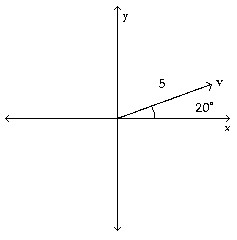Use the graph to estimate the solution of the system of equations.y =  (x - 2) + 2y = - 2(x - 2) + 2
(x - 2) + 2y = - 2(x - 2) + 2
A. ?
B. {(x, -x - 2})
C. {(2, 2)}
D. {(-2, 2)}
Answer: C
You might also like to view...
Determine the discriminant of the quadratic equation. Use the value of the discriminant to determine whether the quadratic equation has two rational solutions, two irrational solutions, one repeated real solution, or two complex solutions that are not real.1 + 2x2 = -2x
A. Two rational solutions B. One repeated real solution C. Two complex solutions that are not real D. Two irrational solutions
Perform the indicated operation and, if possible, simplify. Assume that all variables represent positive real numbers. (4 + 3
+ 3 )(4
)(4 + 2
+ 2 )
)
A. 16 + 6
+ 6
B. 78 + 20
C. 16 + 6
+ 6 + 20
+ 20
D. 18 + 20
Write the vector in the form 
A. 
B. 
C. 
D. 
Find the center, transverse axis, vertices, foci, and asymptotes of the hyperbola. -
-  = 1
= 1
A. center at (2, 3)
transverse axis is parallel to x-axis
vertices at (-2, 3) and (6, 3)
foci at (2 -  , 3) and (2 +
, 3) and (2 +  , 3)
, 3)
asymptotes of y - 3 = -  (x - 2) and y - 3 =
(x - 2) and y - 3 =  (x - 2)
(x - 2)
B. center at (3, 2)
transverse axis is parallel to x-axis
vertices at (-1, 2) and (7, 2)
foci at (3 -  , 2) and (3 +
, 2) and (3 +  , 2)
, 2)
asymptotes of y - 2 = -  (x - 3) and y - 2 =
(x - 3) and y - 2 =  (x - 3)
(x - 3)
C. center at (3, 2)
transverse axis is parallel to y-axis
vertices at (3, -2) and (3, 6)
foci at (3, 2 -  ) and (3, 2 +
) and (3, 2 +  )
)
asymptotes of y + 2 = -  (x + 3) and y + 2 =
(x + 3) and y + 2 =  (x + 3)
(x + 3)
D. center at (3, 2)
transverse axis is parallel to x-axis
vertices at (-2, 2) and (8, 2)
foci at (3 -  , 2) and (3 +
, 2) and (3 +  , 2)
, 2)
asymptotes of y - 2 = -  (x - 3) and y - 2 =
(x - 3) and y - 2 =  (x - 3)
(x - 3)